Trolleybus
![]()
Trolleybus is a redirect to this article. For other meanings, see Trolleybus (disambiguation).
A trolleybus - also known as a trolleybus, trolleybus, trolleybus, trolley or the obsolete trackless tram - is an electric means of transport or transport system in local public transport. It is constructed like a city bus, but unlike the latter, it is not driven by an internal combustion engine, but by one or more electric motors. It draws its traction current - similar to a tram - by means of current collectors from an overhead line stretched over the roadway, which, however, is always double-pole. Trolleybuses are therefore track-bound, but not track-guided. The term trolleybus is used both for the vehicle itself and for the associated infrastructure.
The first systems were opened at the beginning of the 20th century, and a total of 275 trolleybus operations existed worldwide in 47 countries at the beginning of 2020. They are mainly found in Central Eastern Europe, the successor states of the Soviet Union, the People's Republic of China, North Korea, Italy and Switzerland and are listed in the list of trolleybus systems. Over 500 networks have been decommissioned again, an overview of which is given in the list of former trolleybus systems. Most of the former operations existed in the western world, where the trolleybus had its heyday in the 1950s and 1960s. In 30 countries, trolleybuses no longer operate at all.
For a detailed account of the historical development, see the main article History of the trolleybus.
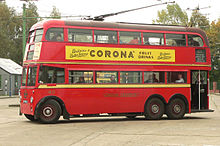
Museum preserved London double decker
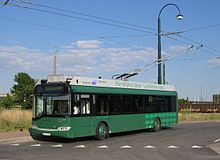
Trollino 12 trolleybus in Landskrona, Sweden
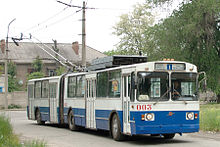
A ZiU-10 in the Ukrainian Krywyj Rih
Definition and legal situation
The trolleybus is a mixture of tram and bus, i.e. it combines elements of a track-bound railway with those of a motor vehicle. This is also noticeable in legal terms - in national legislation it is mostly treated as a railway, not least because only a few states have special regulations for trams. While a distinction is made in the case of buses between regular and occasional services, the trolleybus is used exclusively for regular services.
Germany
Like all German road vehicles, trolleybuses are subject to the Road Traffic Act (StVG), the Vehicle Registration Ordinance (FZV) - formerly the Road Traffic Registration Ordinance (StVZO) - and the Road Traffic Regulations (StVO). In addition the regulation over the enterprise of motor vehicle enterprises in the passenger traffic (BOKraft), the passenger transportation law (PBefG) as well as the regulation over the general conditions of carriage for the tram and trolleybus traffic as well as the regular traffic with motor vehicles apply. In these three regulations the trolleybus as independent means of transport is mentioned separately in each case. It is defined in Germany in the Passenger Transportation Act as follows:
- § 4 (3) Passenger Transportation Act |
The Kraftfahrt-Bundesamt (Federal Motor Transport Authority) classifies trolleybuses among motor buses and coaches and gives them their own code number 22 0000. The Passenger Transport Act, on the other hand, does not define trolleybuses as motor vehicles because they are tied to overhead lines. For the transport with trolleybuses, the transport authorities issue a corresponding permit according to the Passenger Transport Act. Concerning the infrastructure the ordinance over the building and enterprise of the tramways (BOStrab) applies additionally to trolleybus systems. Since there is no special regulation for trolleybuses in Germany, the BOStrab is also applied for the new commissioning of trolleybuses. That means, trolleybuses are certified both as tram and as motor vehicle, whereby for the road-legal permission the TÜV is responsible. The BOStrab is comparatively strict, for example, the fire protection of trams in tunnels must also be taken into account.
The Technical Supervisory Authority (TAB) is an authority designated by the respective state government, the so-called State Authorised Representative for Railway Supervision (LfB). In the case of the Solingen operation in North Rhine-Westphalia, for example, this is the Düsseldorf district government. The TÜV is also responsible for the regular inspection of the overhead line infrastructure; in Esslingen, for example, the electrical systems are inspected every quarter.
Still 1957 was expected in West Germany "in view of the technical and operational peculiarity of this trackless means of transport" the forthcoming enactment of a special regulation about the construction and operation of trolleybus systems (BOObus), to this it came in the end no more.
In Prussia, on the other hand, the approval procedure was still relatively uncomplicated. There, trackless railways - unlike tramways - were not subject to the Prussian Small Railway Act; instead, they only required the approval of the state police and the consent of the road owners. This did not change until the introduction of the Ordinance on Interurban Traffic with Motor Vehicles of October 6, 1931, which stipulated that the regulations and implementation rules for electric railways applied at least to the heavy current systems of the vehicles and the catenary systems. In the Kingdom of Saxony, the "Königlicher Komissär für elektrische Bahnen" (Royal Commissioner for Electric Railways) was also responsible as the railway supervisory authority for trackless railways.
Austria
In Austria, the trolleybus is subject to the Railway Act 1957 (EisbG):
- § 5 Railway Act 1957 |
However, the Tramway Ordinance (StrabVO) issued on the basis of the Railway Act has only contained provisions for trolleybuses since the entry into force of Ordinance BGBl. II No. 127/2018.
In addition to the Railway Act, however, the provisions of road traffic law also apply: the Road Traffic Act 1960 and the Motor Vehicles Act 1967 do not define overhead contact line vehicles as rail vehicles in each case:
- § 2 para. 1 line 24 Road Traffic Act 1960 |
- § 2 para. 1 line 1 Motor Vehicles Act 1967 |
Switzerland
In Switzerland, the trolley bus is governed by its own law, the Federal Act on Trolley Bus Companies, or Trolley Bus Act, abbreviated TrG. It defines the means of transport as follows:
- Federal law on trolley bus companies of 1950, entered into force on 20 July 1951, amended six times since then. |
The Trolleybus Act is supplemented by the Enforcement Ordinance to the Federal Act on Trolleybus Operations, also dating from 1951, known as the Trolleybus Ordinance. Furthermore, the driving and rest times of the personnel as well as the accident reporting are subject to the railway law, the technical equipment of the vehicles and the traffic on the road are again subject to the regulations of the federal legislation on motor vehicle traffic. The Swiss Passenger Transport Act (PBG), on the other hand, does not apply to trolleybuses, and they are not mentioned in it. Furthermore, trolleybuses operate in Switzerland on the basis of a federal concession granted by the Federal Department of the Environment, Transport, Energy and Communications, and not on the basis of cantonal permits for each vehicle, as is the case with buses. This also results in differences in liability insurance. In addition, they do not require a vehicle pass. With regard to catenary systems, the planning approval procedure under the Swiss Railway Act is to be applied, which also applies to trams. Furthermore, the timetables of Swiss intercity trolleybus lines were listed under railways in the Official Swiss Timetable Book until the winter timetable of 1981/82, unlike intercity trolleybuses. Likewise, trolleybuses were listed in the 1950s and 1960s in the directory of rolling stock of Swiss private railways. The Federal Roads Office also does not list trolleybuses as road motor vehicles.
Furthermore, the legal classification as a railway is also partly reflected in labour law and employee protection. For example, the employees of an Austrian trolleybus operation are automatically members of the railway workers' collective agreement. Similarly, the technical acceptance or approval of new trolleybuses is often carried out - analogous to the approval of railway vehicles - by the relevant railway supervisory authority, the so-called railway office. For example, in the Czech Republic by the Drážní úřad or in Italy by the Ufficio speciale trasporti a impianti fissi, or USTIF for short. In general, the approval of a trolleybus is more complex and takes significantly longer than that of a bus. In addition, separate tariffs for trolleybus transport used to be typical for Eastern Europe. To this day, separate tickets are issued in many places - despite the same fare and a joint operating company - which cannot be used reciprocally.
Vehicle registration number
The track-bound nature of trolleybuses, similar to that of a train, is sometimes also noticeable externally. For example, 25 out of 47 countries do not require trolleybuses to have a motor vehicle registration number. This is the case, among others, in Switzerland, even if only since 1940, and in most of the former socialist countries - but not in Germany and Austria. Alternatively, the respective company number must be clearly marked on the outside of the vehicle. This is standard practice for most transport companies anyway, regardless of the legal regulations regarding number plates. In some cases, the orphaned license plate holder is used to indicate the vehicle number. In Austria, newly registered trolleybuses after April 1, 2017 also carry the license plate for purely electric vehicles - newly introduced on that day - i.e. with green instead of black lettering.
without license plate in Europe
BG, BY, CH a, CZ, EST, GR, H, LV, MD, P b, RO c, RUS b, SK, UA
without license plate outside Europe
ARM, GE, J, KP, KS, KSA, KZ, MEX, RA, TJ, UZ
with license plate in Europe
A, BIH, D, E, F d, I d, LT e, N, NL, PL, S, SRB f, TR
with license plates outside Europe
BR, CDN, EC, IR h, MA, MGL i, RC, RCH, USA
a except for duo buses, in contrast to which trolley buses with auxiliary drive also do not require a licence plate
b only vehicles with auxiliary propulsion
c partly municipal number plates, these are inventory numbers of the respective city, furthermore in Romania also duo buses do not need number plates
d until the 1950s regular number plates, then no number plates, since 1984 - or in the case of the Cagliari trolleybus only since 2012 - number plates of the respective province
e Number plates since 2006
f License plate since 2015
h License plate since 2016
i originally only vehicles with auxiliary drive, now all vehicles
In the defunct states of the Soviet Union, Czechoslovakia and Yugoslavia, too, number plates were not mandatory, whereas in the German Democratic Republic, for example, they were.
·
Esslingen trolleybus with authority license plate
· 
Switzerland: Trolleybus without license plate, in the back a diesel bus with license plate
· 
Also in Romania trolleybuses do not need license plates, ...
· 
... instead, some cities use inventory numbers
·
Italian trolleybus with blue provincial license plate
· 
Although Mexican trolleybuses don't need a license plate, this one does
· 
The Czech transport company Dopravní podnik města Pardubic (DPMP) uses the number plate holder to hold the company number, this is not an official number plate
· 
In the 1980s, the French Saint-Étienne still had special license plates in the form STAS (operator) + TR (abbreviation for trolleybus) + operating number.
Driving licence
In order to drive a trolleybus, additional in-house training must be completed in addition to the regular bus driver's licence and the passenger transport licence. In this training, the professional drivers concerned are instructed in the technical characteristics of the vehicles and the electrical systems as well as the technical peculiarities of the operation. Safety regulations, signalling, troubleshooting and additional driving lessons are also part of the training. At the company in Landskrona, Sweden, a minimum of eight hours is estimated for the extra training, at the Schaffhausen trolleybus it is about twenty hours and in Esslingen am Neckar about two weeks. Larger companies maintain special driving school cars, also called training cars, especially for this purpose. In Germany, trolleybus drivers, like tram drivers, must also pass a special aptitude test in accordance with BOStrab after completing their training.
In Switzerland, for example, the additional qualification is also entered on the driver's licence. There, the code 110 certifies that the holder is authorised to drive trolleybuses. Previously, it was entered as a separate category on the driver's licence. In some countries, this separate category still exists today. In Bulgaria it is Tтб, in Estonia D-troll for solo wagons or D-trollE for articulated wagons, in Latvia TROL, in Lithuania T, in Poland 105, in Romania Tb or formerly H and in Hungary TR. In West Germany, in addition to the regular driving licence category 2 for vehicles over 7.5 tonnes, there used to be the category 2e or 2E for electric vehicles, including trolleybuses.
The acquisition of the driver's license was often simplified in the past to facilitate the retraining of rail transport drivers. In some countries, a bus driver's licence is still not required to drive a trolleybus. A passenger car driver's license is sufficient as a basis for additional in-house training. In the German Democratic Republic, a driving licence for electric trolleys was even sufficient. In the People's Republic of China, there are drivers who only have a permit for trolleybuses; they are not allowed to drive diesel buses. A similar situation used to exist in West Germany. There, drivers who only had the above-mentioned driving licence class 2E, but not the so-called large driving licence class 2 plus driving licence for motor buses, were allowed to drive trolleybuses but neither motor buses nor trucks or passenger cars.
Distinction from the trolleybus
Closely related to the trolleybus is the trolleybus, which is used exclusively for freight transport. This is why it is often called a freight trolleybus, although trolleybuses are actually passenger transport vehicles. The designation trolleybus is based in this case on the similarity of the drive system. Independently of it there were in the early years of the system also some few trolleybus systems, on which with in each case own vehicles both freight and passenger traffic took place. A further relevant characteristic was the trolleybus Sankt Lambrecht in Austria. There - similar to a combination bus - special vehicles served both the freight transport and the passenger transport. The outdated term trackless railway was used synonymously for both trolleybuses and trolleybuses. In Russia and Ukraine, some companies use trolleybuses as work trucks for repair and maintenance work of urban trolleybus networks. Some trolleybuses also carried mail, usually when they previously replaced stagecoach connections.
· 
A KTG-1 work car in Donetsk, Ukraine.
· 
An early Austrian trolleybus with k.k. Post compartment
Marking of stops
Typical for trolleybus lines is the special marking of the stops. While this is still standard in Central and Eastern Europe today, transport companies in Western Europe now rely on uniform station signage regardless of the mode of transport. However, this was not always the case. Thus existed in Germany and Austria starting from 1939 also for trolleybuses uniform yellow-green stop signs. Here one used however not the circular tramway signs, but the stop flags and/or stop spoons in form of a signal arm, actually intended for motor vehicle lines. Instead of as usual with the name of the bus enterprise the signal arm was marked however with the inscription Obus and/or OBUS. In Hamburg and Hanover were deviating from it rectangular two-line plates with the inscription trolleybus stop and/or trolleybus stop in black writing on white reason to be found. Likewise in Switzerland, there however with the inscription Trolleybus Haltestelle. In Italy one marked pure trolleybus stops with FERMATA FILOBUS, mixed trolleybus and bus stops however neutrally with FERMATA. Still in the 1980s the public utility Solingen marked the departure points of their trolleybuses on the central Graf-Wilhelm-Platz as platform. A further trolleybus-typical characteristic compared with the omnibus is to attach the stop signs directly to the cross wires of the overhead line.
· 
Ukrainian trolleybus stop ("T") in Sevastopol
· 
Joint trolleybus and bus stop in the Czech Republic
· .jpg)
Common tram, bus and trolleybus stop in the Czech Republic
· 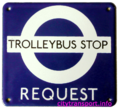
Marking of a demand stop on the London trolley bus
· 
Historic German trolleybus stop flag in Eberswalde, top left
· 
Saint Petersburg: Stop sign attached directly to a cross wire of the overhead line
Line marking
Sometimes trolleybus lines are or were also differentiated by a prefixed "O" (Graz, Hamburg, Hanover, Linz, Minden, Munich and Berlin) or a prefixed "T" (Burgas, Mediaș, Piatra Neamț, Satu Mare, Sibiu and Ulaanbaatar). In Berlin the first three trolleybus lines opened in the 1930s - which were all located in the western part after the division of the city - were still marked with the prefix "A" for autobus introduced in 1929, which did not change until the end of operation in 1965. Only East Berlin introduced the identifier "O" for its subnetwork, which was opened in 1951. Alternatively, the Romanian company Transurb Galați uses the suffix "T" for its two trolleybus lines 102T and 104T, while the autobus lines there manage without letters at all.
In Jihlava and Tychy the principle applies to designate trolleybus lines with letters and bus lines with numbers. In Bern between 1947 and 1974, in Koblenz between 1942 and 1970 as well as in Salzburg between 1966 and 2003 it was however exactly the opposite, in the three cities mentioned had in each case trolleybus lines numbers and bus lines letters. In Salzburg today the trolleybus lines are assigned individual identification colors, while the bus lines are marked uniformly violet.
In Augsburg, Erfurt, Kassel and Regensburg the trolleybus lines had in the first years of operation in each case no line numbers and differed thereby from the regularly designated local bus lines. Differently with the trolleybus Budapest, where the - in the early years only line - temporarily carried the line designation "T" for "Trolibusz", while all tram and bus lines had numerical designations. Likewise, the last remaining Moscow trolleybus line bears the letter "T". Also in Vaslui, Romania, the cars of the only trolleybus line are signposted with "T" for "Troleibuz", while the buses of the responsible company Transurb run without any line designation at all. Another special feature existed in Bremerhaven, where tram lines were designated with Arabic numerals from 1908, trolleybus lines with Roman numerals from 1949 and bus lines with letters from 1940.
In the successor states of the Soviet Union it is widely common to assign the same line numbers - without any addition - for trolleybus as well as for bus and tram lines. In this case there can be for example a tram line 1, a trolleybus line 1 and a bus line 1 parallel to each other, which sometimes even serve the same stops. Outside the former USSR, this system was also used in Budapest and Timișoara at times, and is still the case in Ulaanbaatar today.
Alternatively, in many cities trolleybus lines are assigned lower line numbers than bus lines, but higher line numbers than tram lines - i.e. there is a hierarchical system. This can lead to a situation where a trolleybus line is assigned a new line number in the course of its conversion to trolleybus or a trolleybus line is assigned a new line number in the course of de-electrification, although the routing does not change.
· 
Differentiation between trolleybus ("T") and bus ("A") lines in Izhevsk
· 
Line marking "T1" in Sibiu
· 
Timetable of the Berlin line O 37, beside the additional letter O and the trolleybus symbol also the terms train and train sequence - instead of car and car sequence - indicate the trolleybus operation
· 
The last remaining Moscow trolleybus line "T".
· 
Rīga: a coach of bus line 3 follows - without further distinction - a coach of trolleybus line 3
Design of city and line network plans
Furthermore, it is customary to assign trolleybus lines an independent identifier on city or route network maps. In the Soviet Union and many of its sister states, the identification colour green prevailed, while trams were marked in red and buses in blue, as they still are today. This colour scheme was often the basis for the design of the respective tickets. The public utilities Solingen mark their trolleybus lines - analogous to the railway lines - with double line width, while bus lines are represented in single line width. An alternative for black and white plans is to distinguish the different means of transport with solid, dashed or dotted lines. In Germany, on the other hand, tram lines were at times marked with a solid red line, trolleybus lines with a solid blue line, and omnibus lines with a dashed blue line. The Boston Elevated Railway, on the other hand, used circles for streetcar line numbers, squares for bus line numbers, and triangles for trolleybus line numbers in their line network maps.
If, on the other hand, trolleybus lines are not marked separately, it is not clear to the passenger from the timetable documents which means of transport is being used. Furthermore, there are city maps on which only the trolleybus lines are marked, but not the bus lines.
· 
Three-colored network map from East Berlin, tram lines are red, trolleybus lines are green and bus lines are blue
· 
Two-colour network map from Opava, trolleybus lines are marked in red and bus lines are marked in blue.
· 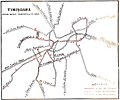
Network map from Timișoara: tram lines continuous, trolleybus lines dashed and bus lines dotted.
Marking of vehicles
- Painting: In many places, it is also typical to have a separate painting scheme for trolleybuses, although they are operated by the same company as the rest of the urban transport. Examples are Budapest (trolleybuses red-grey, buses blue-grey and trams yellow-white), Plzeň (trolleybuses green-white, buses red-white and trams yellow-grey), Minsk (trolleybuses blue-green, buses light-green and trams turquoise) and until 2010 Belgrade (trolleybuses orange, buses yellow and trams red).
- Numbering: Sometimes the same operating numbers are assigned, so that the same transport company may have a trolleybus number 1, a bus number 1 and a tram number 1. In Idar-Oberstein, additional abbreviations were used in the past for this purpose, so there was a trolleybus "O1" and a bus "K1" at the same time. The Aachener Straßenbahn und Energieversorgungs-AG also used the additional letter "O" for their trolleybuses, and for the Greiz trolleybus the additional letter was "Ob". Similarly, in Budapest, Glasgow and Warsaw, the prefixed code letter "T" existed, in Szeged this is still the case today. For the intercity service from Turin to Rivoli, the additional letter "F" was for filobus, in the Romanian Timișoara the "F" stood analogously for firobuz.
- Typing: Many manufacturer designations are also based on this system, for example the trolleybus type derived from the bus model Ikarus 280 is called Ikarus 280T. In addition, it is common practice to assign independent number groups to trolleybuses. Thus for example in Esslingen the articulated trolleybuses have 200 numbers, while the articulated buses are marked with 100 numbers.
·
Road number "T-600" in Szeged
· .jpg)
Budapest: while buses are painted blue-grey,...
· .jpg)
...trolleybuses are kept in a red-grey design...
· _trolleybus_(detail)_-_Flickr_-_James_E._Petts_(1).jpg)
In London, trolleybuses were at times marked with this logo
Operator
As a rule, trolleybuses are operated by municipal or private transport companies. These are usually also responsible for the local bus and - if available - tram transport. However, in certain cities there is an organisational separation between trolleybus and bus transport. In the European Union, Norway and Switzerland this is or was the case in Bergen (since 2020), Chaskowo, Gdynia (since 1998), Pazardzhik, Pleven, Salzburg (since 2005), Sofia, Stara Sagora, Szeged, Tychy and Wraza. Likewise - in each case from the opening of the plant - in Bern until 1947, in Bonn until 1964, in Budapest until 1967, in Schaffhausen until 1984, in Debrecen until 2009, in Athens/Piraeus and Vilnius until 2011, in Tallinn until 2012 and in Kaunas until 2014, as well as at the four closed Bulgarian plants in Dobrich, Kazanlak, Pernik and Veliko Tarnovo. Outside Europe, trolleybuses and omnibuses are administratively separated in Guadalajara, Guangzhou, Quito, Mendoza, Mexico City, Valparaíso and Wuhan, for example, and this was previously the case in Mérida. Furthermore, this model is also used in many cities of the former Soviet Union. In addition, as in North Korea or earlier in China, some trolleybus systems there are run by industrial enterprises. These are non-public factory passenger services that are usually only operated at shift changes. Pure trolleybus companies were also the Spanish Compañía de Trolebuses Santander-Astillero, abbreviated CTSA, and the Uruguayan COOPTROL, an acronym for COOPerativa de TROLebuses, from Montevideo.
Some of the trolleybuses are also affiliated with the tramway operations, for example in Sofia and Szeged. This results, among other things, in synergy effects in the maintenance of overhead contact lines and in the purchase of electricity. In Chile, there used to be a state-owned company that operated both of the country's trolleybus networks jointly, most recently under the name Empresa de Transportes Colectivos del Estado. In Switzerland, with the company Transports Publics Neuchâtelois (transN), which was created in 2012 as a result of a merger, there was again a company that was responsible for two geographically separate trolleybus networks, in this case for the trolleybus Neuchâtel and the - now discontinued - trolleybus La Chaux-de-Fonds.
Numerous transport companies changed their names in the course of the introduction of trolleybuses in order to eliminate the term tramway. For example, the tramway of the city of St. Gallen called itself neutral Verkehrsbetriebe der Stadt St. Gallen from 1950. The French transport company Société des Trolleybus Urbains de Belfort (STUB), in turn, carried its name from 1952 to 1972, although it also operated buses from 1958. The transport company of the Croatian city of Rijeka is still called KD Autotrolej d.o.o., although no trolleybuses have been operating there since 1971. Similarly, the bus company of the Romanian city of Piatra Neamț is still called S.C. Troleibuzul S.A., although trolleybus operations there only ended in March 2017.
· 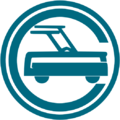
Logo of the trolley bus operator in Guangzhou, China
·
Logo of the operating company of the trolleybus Valparaíso
· 
Logo of the trolleybus operator ЧТУ in Chernihiv, Ukraine
·
Autotrolej today operates only buses, but kept the name
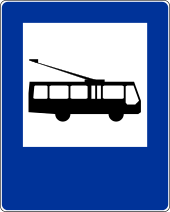
bus stop sign in Poland

Salzburg: the trolleybus lines listed above have individual identification colors, the bus lines shown below do not.

Driving school car at the Luzern public transport company

Logo of the former company Vilniaus troleibusai, which was a pure trolleybus operator
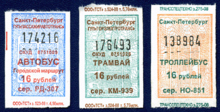
St. Petersburg: separate tickets for bus, tram and trolleybus
Etymology
Trolleybus is a short form of the term trolleybus, which is composed of trolley and omnibus.
Oberleitungsomnibus appeared even before World War I, for example in an advertisement by Siemens & Halske in 1901. The abbreviated form trolleybus was officially introduced in September 1937 by the Railway Committee of the Association of German Transport Authorities (VDV). However, the word itself is older, appearing for example as early as 1930 in the magazine Der Waggon- und Lokomotivbau.
The abbreviation for trolleybus or trolleybus was first Obbus and was later simplified to the today common spellings Obus or O-Bus.
The term trolleybus used outside Germany and Austria is an internationalism. While in British English or in the rest of Europe sometimes its short form trolley is used, trolley in American English is the short form for trolley car and stands there for a tram.
The name comes from crane trolley, which is the English name for a trolley on the boom of a crane. This has a great technical similarity to the contact wagons, which ran on the overhead line of both the first electric trams and the first trolleybuses and were pulled behind with the connecting cable. However, the term trolleybus was not coined until the 1920s, i.e. at a time when the initial systems with contact wagons had long since become technically obsolete and had largely been decommissioned.

Historical bus stop sign from Prague with the Czech transcription Trolejbus

Siemens & Halske advertisement from 1901
Search within the encyclopedia
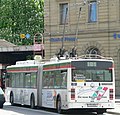



.JPG)